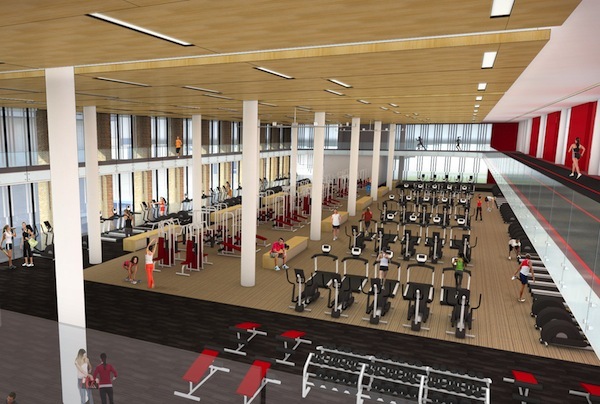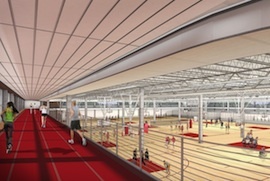Students to vote on campus recreational sports improvements

An architect’s rendering shows how a fitness area at the SERF would look after completion of the project.
Renderings by: Kahler Slater Architects
A significant upgrade to the campus’ heavily used recreational sports facilities will be one of the options facing students during the University of Wisconsin–Madison spring student elections, held March 3-5.
The Recreational Sports Master Plan includes expansion and renovations of the Southeast Recreational Facility (SERF) and Natatorium as well as improvements to the Near West and Near East playing fields.
Rec Sports had more than 1.7 million visits by users in 2012-13, including 83 percent of the student body. A new master plan is needed because the facilities have become outdated and are overcrowded, and it will take a considerable financial commitment by students to repair existing facilities says John Horn, director of the Division of Recreational Sports at UW–Madison.
“We would like to serve campus better and provide not only more space for people to be active but facilities that really support a healthy lifestyle. We currently are well below the national standards both in space and quality across all of our recreational facilities,” Horn says.

This drawing shows the exterior of the renovated SERF.
Upgrades at the SERF and Natatorium would include regulation-size courts for basketball, volleyball, badminton and futsal, numerous multipurpose rooms, new indoor tracks and racquetball/squash courts.
There would also be three times the current amount of cardio and strength fitness space at the SERF plus renovations to the existing 50-meter pool and a wellness suite.
At the Natatorium, there would be seven times the current amount of cardio and strength fitness space plus an eight-lane recreation & instruction pool, indoor turf field, ice rink and wellness suite. An indoor track is included in the Natatorium plans as no indoor running facility is available on the Lakeshore side of campus.
The plans for the outdoor fields include four soccer fields at the Near East site (with an additional championship field) and the expansion to five flag football fields at the Near West site. All fields are planned to be lined with Ecofill turf made from recycled materials.
The proposed plan is estimated to cost approximately $223 million. In addition to student segregated fees, funding sources include a combination of gifts, the state, UW Athletics and Rec Sports program revenue. At the request of students, Rec Sports has successfully kept the student proportion of funding for the upgrades consistent with their current share of funding support for Rec Sports operations.
Students currently pay $36.78 per semester in segregated fees for recreational sports and facilities. On average, Big Ten students pay $145.06 per semester for recreation programs. Given the current funding model for the referendum, the segregated fee is scheduled to come in below the Big Ten Rec Sports fee average for students. The proposal would result in a segregated fee increase of no more than $108 per semester.

The proposed look of the renovated Natatorium track and courts is shown in this rendering.
Not only would the new master plan benefit students, but alumni would be able to purchase memberships for the upgraded facilities.
Although the master plan initially included a 50-meter competition swimming pool and diving well, following through on that option was contingent upon students funding at least $13 million of the facility, combined with additional sources committing to funding the other half of what is currently estimated to be at least a $26 million cost. At this point, no additional funding has become available.
Should additional gift funding become available for a competition pool at the SERF prior to the design process, the competition pool could be considered with no additional financial impact on students.
The master plan depends on the support of student votes in order to move forward. If the referendum doesn’t pass, Horn says students’ segregated fees will likely increase in order to accommodate the amount of repairs necessary to maintain and repair existing facilities.
If approved, construction could begin in 2017 with a new SERF opening in 2019 and new Natatorium in 2021. The Near West and Near East fields are expected to be completed in 2016 and 2022, respectively.
“These improvements will help us provide the kinds of facilities our campus community deserves for the next 40 to 50 years,” Horn says.
More information about the Rec Sports plan can be found here.




